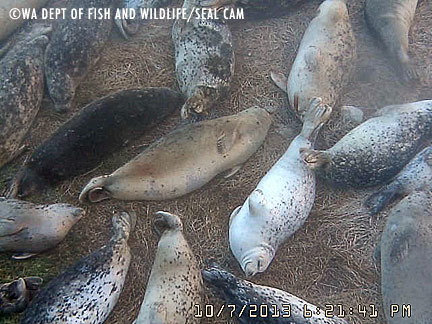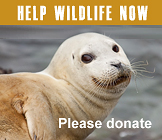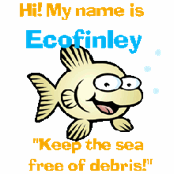Tiger
Weather cools down, but seal pup activity heats up
Oct/17/13 07:25 PM
Just as fall weather has turned very brisk, so has the number of seal pup responses along West Seattle’s shoreline. There has been a noticeable increase in activity the past week or so. According to Seal Sitters volunteer Richard, an avid diver, he has been seeing more bait balls of the small forage fish that are indispensable to the marine ecosystem and a favorite food of seal pups (read more about forage fish here). Last evening until just after dark, Richard and fellow volunteer Suzanne looked over new pup Humphrey who snoozed below Beach Drive. A very tiny pup, Humphrey could stand to snack on some of those fish and pack on some blubber to keep him warm in Puget Sound’s frigid waters. He returned to the water sometime overnight.
Seal pup Tiger continues his/her routine of hauling out just around dark every evening on the Elliott Bay side of West Seattle. He is thriving and it is a joy for volunteers to see such a seemingly healthy, vigorous pup. Tiger does seal pup yoga on the smooth beach sand, stretching his tail high and curving his body into a “u” shape - the classic “banana pose”. This behavior is his way of circulating warmth - or thermoregulating his temperature.
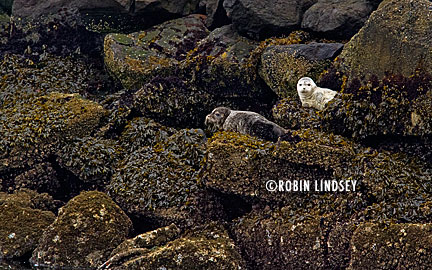 On a somewhat unusual note, for the past two days (possibly more that we were unaware of) pups have been hanging out together on the rocks along one of the sea walls. These young harbor seals come in at high tide during the night and are left quite vulnerable resting on the jagged rocks far above the water level, where they wait for the tide to return.
On a somewhat unusual note, for the past two days (possibly more that we were unaware of) pups have been hanging out together on the rocks along one of the sea walls. These young harbor seals come in at high tide during the night and are left quite vulnerable resting on the jagged rocks far above the water level, where they wait for the tide to return.
Each morning, responders have taped off the area above them so that they can rest undisturbed and not be at risk for fall and potential injury. Despite this, on Tuesday morning a woman went under the tape clearly marked with a “Do Not Enter” sign, standing a few yards from the pups and refused to leave, asking what harm she was doing. We tried to explain to her that there was a very real danger to these pups if they were scared and tumbled down 15 feet of craggy rocks with deep holes (seal pups Henry and Spanky fell deep into holes in past seasons).This is, of course, beside the fact that going under the tape and disturbing a maine mammal is breaking a federal law, the Marine Mammal Protection Act (read more here). It was quite sad that this woman created a contentious scene over our efforts to give these pups some rest. The pups could easily be seen from a sidewalk viewpoint and the posted signs explained that seal pups need undisrupted, stress-free rest to survive against challenging odds - a 50% mortality. People standing too close is most definitely a source of stress, which has been proven in many studies to negatively impact health in humans and animals. Thankfully, unpleasant incidents are rare. Most people are thrilled and empowered to be able to help a pup survive by simply giving them space.
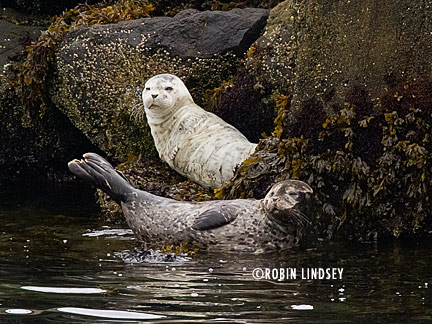 Volunteers set up a viewing scope so that the public could get an exceptionally close view of the pups, one with a beautiful light coat and the other with luxurious dark fur. It was a fantastic opportunity for passersby to learn about seal pup biology and behavior. The two pups returned to Elliott Bay mid-afternoon Tuesday when the tide finally reached them (photo right). The body weight of these two weaner pups seems to reflect that there is indeed more of a food source out there and we’ve observed quite a few pups fishing offshore. Most often, a pup will haul out close to where he is foraging.
Volunteers set up a viewing scope so that the public could get an exceptionally close view of the pups, one with a beautiful light coat and the other with luxurious dark fur. It was a fantastic opportunity for passersby to learn about seal pup biology and behavior. The two pups returned to Elliott Bay mid-afternoon Tuesday when the tide finally reached them (photo right). The body weight of these two weaner pups seems to reflect that there is indeed more of a food source out there and we’ve observed quite a few pups fishing offshore. Most often, a pup will haul out close to where he is foraging.
Yesterday morning before dawn, two light-coated pups were resting in almost the same spot. Unfortunately, as daylight increased, so did their nerves. The first jittery pup scooted back down the rocks to get to the water, tumbling the last few feet before landing in the bay with a big splash. This prompted the other pup to follow suit, disappearing in a watery splat.
These pups, only 2-3 months old, are now on their own with no adult to protect them. There is certainly safety in numbers for newly weaned pups; while one catches a snooze the other can be on the alert, providing a more satisfying rest. In all, Seal Sitters responded to 4 pups in West Seattle yesterday, with 3 the day before. We are comparing distinct markings to determine if the pups on the rocks are new visitors to our shores and will update Blubberblog with our findings.
Seal pup Tiger continues his/her routine of hauling out just around dark every evening on the Elliott Bay side of West Seattle. He is thriving and it is a joy for volunteers to see such a seemingly healthy, vigorous pup. Tiger does seal pup yoga on the smooth beach sand, stretching his tail high and curving his body into a “u” shape - the classic “banana pose”. This behavior is his way of circulating warmth - or thermoregulating his temperature.

Each morning, responders have taped off the area above them so that they can rest undisturbed and not be at risk for fall and potential injury. Despite this, on Tuesday morning a woman went under the tape clearly marked with a “Do Not Enter” sign, standing a few yards from the pups and refused to leave, asking what harm she was doing. We tried to explain to her that there was a very real danger to these pups if they were scared and tumbled down 15 feet of craggy rocks with deep holes (seal pups Henry and Spanky fell deep into holes in past seasons).This is, of course, beside the fact that going under the tape and disturbing a maine mammal is breaking a federal law, the Marine Mammal Protection Act (read more here). It was quite sad that this woman created a contentious scene over our efforts to give these pups some rest. The pups could easily be seen from a sidewalk viewpoint and the posted signs explained that seal pups need undisrupted, stress-free rest to survive against challenging odds - a 50% mortality. People standing too close is most definitely a source of stress, which has been proven in many studies to negatively impact health in humans and animals. Thankfully, unpleasant incidents are rare. Most people are thrilled and empowered to be able to help a pup survive by simply giving them space.

Yesterday morning before dawn, two light-coated pups were resting in almost the same spot. Unfortunately, as daylight increased, so did their nerves. The first jittery pup scooted back down the rocks to get to the water, tumbling the last few feet before landing in the bay with a big splash. This prompted the other pup to follow suit, disappearing in a watery splat.
These pups, only 2-3 months old, are now on their own with no adult to protect them. There is certainly safety in numbers for newly weaned pups; while one catches a snooze the other can be on the alert, providing a more satisfying rest. In all, Seal Sitters responded to 4 pups in West Seattle yesterday, with 3 the day before. We are comparing distinct markings to determine if the pups on the rocks are new visitors to our shores and will update Blubberblog with our findings.
Finally - a chubby seal pup to lift volunteers' spirits
Oct/12/13 10:23 PM
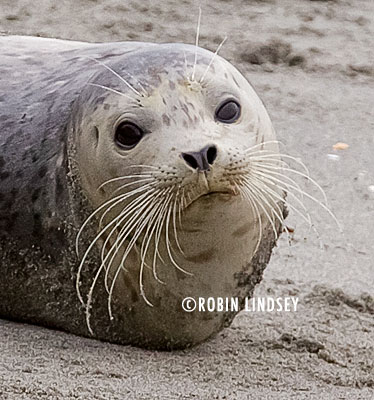
Tiger shows off a magnificent set of whiskers which he will shed next year during his first molt. Since newborn harbor seal pups shed a long and wavy white lanugo coat inside the womb (unless born prematurely), he will not be molting his new spotted fur until next season. However, once a pup reaches a year old, he will shed all his fur and whiskers (called vibrissae) annually over a period of one-two months immediately following breeding season. It takes many months for the whiskers to reach full length again. Seals do use their vibrissae to help them locate and identify prey by sensing motion, but during the very uncomfortable molt they tend to stay onshore for the most part and rely on fat storage for energy. This is why it is critical for seals to bulk up before the late fall and winter months since their weight will drop during the molt.
Seal pups on shore briefly today and others hanging around
Oct/11/13 09:47 PM
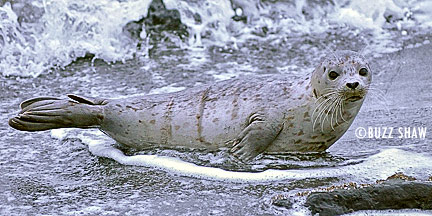
Later in the afternoon, 4 pups were observed foraging along the shoreline, but none that we know of came ashore. A pup was also sighted briefly on the protected beach at Jack Block Park. Perhaps the pups are resting at night or in locations that are less visible. The good news is, however, that we have pups still hanging around West Seattle and that they seem to be actively feeding. In the photo you can see Tiger’s long whiskers which detect vibrations from prey in the water. A recent study showed that the highly sensitive vibrissae contain thousands of nerves which enable a seal not only to locate prey, but determine size and species. This is why harbor seals are very effective hunters even at night or in deep, dark waters.
All of the harbor seal pups in South Puget Sound are now fully weaned. Almost all of the youngsters have left the relative safety of the rookeries to venture off on their own - and area haul-outs are full of grumpy adult seals, molting their coats and spending extended time on shore and less time feeding. While the molting process of harbor seals is not as grueling as the “catastrophic molt” of elephant seals, it is still a very trying time, particularly as winter months approach. Females who expended all of their resources to nurse pups for 4-6 weeks now face the additional physical stress of the molt. Thanks to WDFW-MMI for providing this seal cam photo of a freshly molted seal with a smooth new coat along with others who are still molting. Don’t forget to check out the WDFW seal cam webpage for a real-time look at a harbor seal haul-out and lots of informative articles and videos.
Haul-outs this time of year are not a welcoming place for new “weaners” to linger. All the more reason we need to offer them sanctuary on our urban beaches.
